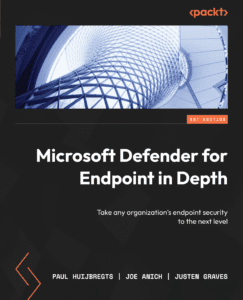Justen Graves is the author of Microsoft Defender for Endpoint In Depth we got the chance to sit down with him and find out more about his experience of writing with Packt.
Q: How did you become an author for Packt? Tell us about your journey. What was your motivation for writing this book?
Justen: My friend and colleague, Joe Anich, had just finished a certification prep book for Microsoft’s SC-200 exam. I reached out to congratulate him and mentioned I’d always wanted to write a book and to let me know if he was interested in doing another one. He said he was already brainstorming a project on Microsoft Defender for Endpoint with a member of the Defender product group (Paul Huijbregts) and that he’d love to add me to the project. It was a great opportunity, as I’ve always been an avid consumer of books (both fiction and non-fiction) and always thought I’d enjoy the writing process, but never had time due to my career being such a heavy focus. Since this allowed me to share experience and build additional knowledge through research, it was the perfect way to test the waters of writing without distracting from my career aspirations.
Q: What is the name of your book?
Justen: Microsoft Defender for Endpoint In Depth.
Q: What kind of research did you do, and how long did you spend researching before beginning the book?
Justen: Paul, Joe, and I all brought different subject matter expertise to the book, so not much research was required prior to starting. Paul understood the mechanics of the product, Joe understood deployment and integration of the product into customer environments, and I had the most practical experience leveraging the product for security operations work. However, once we got started, I had to do a lot of research to help review and flesh out ideas that Paul and Joe were writing about, as well as to ensure accuracy since the products are constantly evolving.
Q: What key takeaways do you want readers to come away with from the book?
Justen: I want readers to come away with respect for the evolution of Microsoft Defender products in general, a clear understanding of how to implement Microsoft Defender for Endpoint, and the tools needed to be successful in utilizing it in their environment – regardless of how simple or complex that environment might be.
Q: Can you share any blogs, websites and forums to help readers gain a holistic view of the tech they are learning?
Justen: I really love Jeffrey Appel’s stuff (https://jeffreyappel.nl/) and recommend our friends over at Cloud Conversations as well (https://www.youtube.com/@CloudConversations).
Q. Did you face any challenges during the writing process? How did you overcome them?
Justen: Yes, I faced many challenges during the writing process. The most significant was time. Writing the book was much more time consuming than I realized it would be. It’s a very involved process, and I was finishing up an MBA at the same time we were writing the book. In the end, I was only able to get through it because of the support of my coauthors, the Packt editorial team, and having dedicated days on the weekend where I locked my office door and did nothing else from dawn to dusk.
Q. How would you describe your author journey with Packt? Would you recommend Packt to aspiring authors?
Justen: Packt was great to work with and I think it’s a wonderful company to author your first book with, especially if you are unsure where/how to start. Packt gives you templates and guidance throughout the process and makes it easy to be successful, while also being open to adjustments if you have a vision you’re trying to stick to.
Q. Why should readers choose this book over others already on the market? How would you differentiate your book from its competition?
Justen: Our book is the only one that conveys how to actually succeed at securing your environment with Microsoft Defender for Endpoint from soup to nuts. Others tend to focus on implementation or operations, not both. However, our book starts with where the product came from and what its capabilities are, then walks through how to get it deployed in an environment, then finishes with practical examples of how to actually perform security operations work with it. This gives someone working on their own at a small business a holistic view of how to maximize the value of the product and those that are small cogs in huge enterprises valuable perspective on the roles and responsibilities of those they’re either trying to support or being supported by.
Q. What is/are your specialist tech area(s)?
Justen: Cybersecurity, Information Security, Security Strategy, Security Architecture, Microsoft Windows, Microsoft Defender for Endpoint, Microsoft Intune, Microsoft Azure Infrastructure, Identity.
Q. What advice would you give to readers jumping into this technology? Do you have any top tips?
Justen: Don’t be afraid of it. It seems really complex on the surface, but the product is built to meet you where you are, and to let you ease into it on your own schedule. There’s a great community of Microsoft Defender for Endpoint folks out there on Twitter and LinkedIn that you should engage with if you need help and the documentation and our book aren’t getting you there.
Q. What’s your take on the technologies discussed in the book? Where do you see these technologies heading in the future?
Justen: As AI becomes an ever-more-present aspect of cybersecurity, the technologies behind Microsoft Defender for Endpoint will become even more sophisticated behind the scenes, while also becoming progressively simpler for the end user. Once AI can deliver advanced detection and response automation that customers can confidently rely on (both to protect them and to not break their environments), the burden on security analysts will move more toward pure investigator over computer engineer. When the tools are able to surface everything one needs, the focus will shift to using detective skills to read between the lines.
Q. How did you organize, plan, and prioritize your work and write the book?
Justen: We handled work prioritization as a group. I was fortunate to have coauthors that were invested and a clear vision from our outline of who owned which sections. Planning my own time commitment was the hardest part, and due to other obligations (like my aforementioned MBA), a lot of my time spent on the project was ad-hoc as I could. I’d recommend a strict weekly regimen though, if possible. Try to dedicate a few hours a night or a solid day on the weekend each week to work on it. Procrastination will drive some pretty gnarly anxiety, so stay on top of stuff and keep making progress, even if it’s only a little at a time.
Q. What are your favorite tech journals? How do you keep yourself up to date on tech?
Justen: I have RSS feeds for major cybersecurity news folks like Krebs on Security and am also a member of cyber intel Discord groups that are generally private (unfortunately).
Q. Would you like to share your social handles? If so, mention them below.
Justen: Yes, of course. Here you go: @justgravy on Twitter, https://www.linkedin.com/justengraves.
Q: What is that one writing tip that you found most crucial and would like to share with aspiring authors?
Justen: Don’t let fatigue hurt the quality of the book. As you get deep into the process, you’ll eventually hit a point where you just want to be done at all costs. When you hit that point, don’t start phoning it in. Take a deep breath and a step back, recharging however works best for you, and remember that once it’s in print you’ll want it to be the highest possible quality. Take the time and do the work. If you do, in the end you can not only be relieved it’s done, but also both satisfied with the result and happy that your name is on it.
You can find Justen’s book on Amazon by following this link: Please click here









